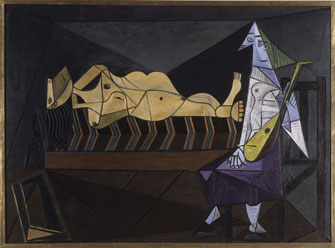Explaining Art in War
Is an Uphill Battle

Picasso’s ”L’Aubade” (”Tombstone,” 1942). © Centre Pompidou, MNAM-CCI, Dist. RMN/Christian Bahier/Philippe Migeat © Succession Picasso 2012
“L’Art en Guerre” (“Art in Wartime”) at the Musée d’Art Moderne de la Ville de Paris is an ambitious — rather too ambitious — exhibition. While full of interesting exhibits, it spreads itself far too thin by trying to cover every aspect of what happened in the art world in France in the decade beginning in 1938 and would have benefited greatly from zeroing in on one or a few of them.
The exhibition begins with a re-creation of the 1938 Surrealist exhibition put together by André Breton and Paul Éluard at the Galerie des Beaux-Arts in Paris. Its relevance? It seemed to be predicting the upcoming war with a grotto-like room with coal bags hanging from the ceiling, so dark that visitors were handed flashlights to see the artworks.
Many of the artists whose work was exhibited there ended up going into exile. Some were interned in French camps for enemy nationals before the war started, including Max Ernst and Hans Bellmer (the inhabitants of these camps changed, of course, after the German occupation of France in 1940). Works made by them and others while in the camps, including a number of sensitive drawings by Bellmer, among them a portrait of Ernst, are on show, along with interesting pieces by artists I was unfamiliar with, including Wols (Alfred Otto Wolfgang Schulze) and Raoul Hausmann.
Documentary sections full of propaganda and information posters and photos provide some context for the pro-German, anti-Semitic, nationalistic and Pétain-worshipping atmosphere the French lived with during the Occupation.
Then there are works by the masters who stayed in France and survived, among them Matisse, Bonnard and Rouault, who stayed in the South of France. Picasso, who was not allowed to exhibit during the Occupation and spent his time working feverishly in his Paris studio on the Rue des Grands Augustins, is represented by an entire roomful of pieces he produced during the war.
This section is followed by one showing unfamiliar works by “young painters in the French tradition.” It is not entirely clear from the wall text whether these painters were collaborators with the Vichy regime or subversive resistants. Probably a mixture of both.
The exhibition’s layout can also be confusing. After the young painters, you walk into a circular room full of heroic-looking statues. Aha, you think, these must have been made by Nazi-approved artists depicting the Aryan ideal. But a glance at the dates on the labels shows that some of them were made as early as 1928 and most of them in the early ’30s. So what are they doing here? A mystery, until you walk into the next room and read the wall text. Apparently, although it still isn’t made entirely clear, the statues were among the sanctioned works shown in this very museum when it first opened in 1942, at the height of the Occupation, along with the paintings on display in this room. Abstract, Surrealist and foreign artists were excluded from the museum by the Vichy government’s appointee to its directorship.
Among the approved artists are Bonnard, Braque and Raoul Dufy, for example, whose work is shown alongside that of Vlaminck, Derain and Van Dongen, who at least implicitly collaborated with the occupiers by participating in a trip to Germany with Arno Breker, Hitler’s official state sculptor, in 1941, leading you to wonder if all of the artists shown in the room were somehow tainted, but with little information to help you figure out who were the good guys and who the bad.
The show goes on with a section on the Paris gallery of Jeanne Bucher, who during the Occupation continued to show the work of many foreign or “degenerate” artists, among them Henri Laurens, Jacques Lipchitz, Arpad Szenes, Nicolas de Staël, Joaquín Torres-Garcia and Maria Helena Veira da Silva.
When the war ends, we get explosions of color from Matisse and other artists, darker works from the likes of Germaine Richier and Otto Dix, the return of abstraction and modernism, and new movements like Jean Dubuffet’s Art Brut.
The show ends with a display case filled with small sculptures by Alberto Giacometti (who spent most of the war years in Switzerland), whose relevance is not entirely clear, except that he was an artist working in France after the war.
It was a great idea, but with no fewer than 11 different sections and over a hundred artists, this exhibition with a patched-together feel reaches in far too many directions, and in the end is more disjointed and confusing than illuminating.
Musée d’Art Moderne de la Ville de Paris: 11, avenue du Président Wilson, 75116 Paris. Métro: Alma-Marceau or Iéna. Tel.: 01 53 67 40 00. Open Tuesday-Sunday, 10 a.m.-6 p.m. (Thursday until 10 p.m.). Closed on public holidays. Admission: €11. Through Feb. 17, 2013. www.mam.paris.fr
Reader reaction: Click here to respond to this article (your response may be published on this page and is subject to editing).
Please support Paris Update by ordering books from Paris Update’s Amazon store at no extra cost. Click on your preferred Amazon location: U.K., France, U.S.
More reviews of Paris art shows.
© 2012 Paris Update
